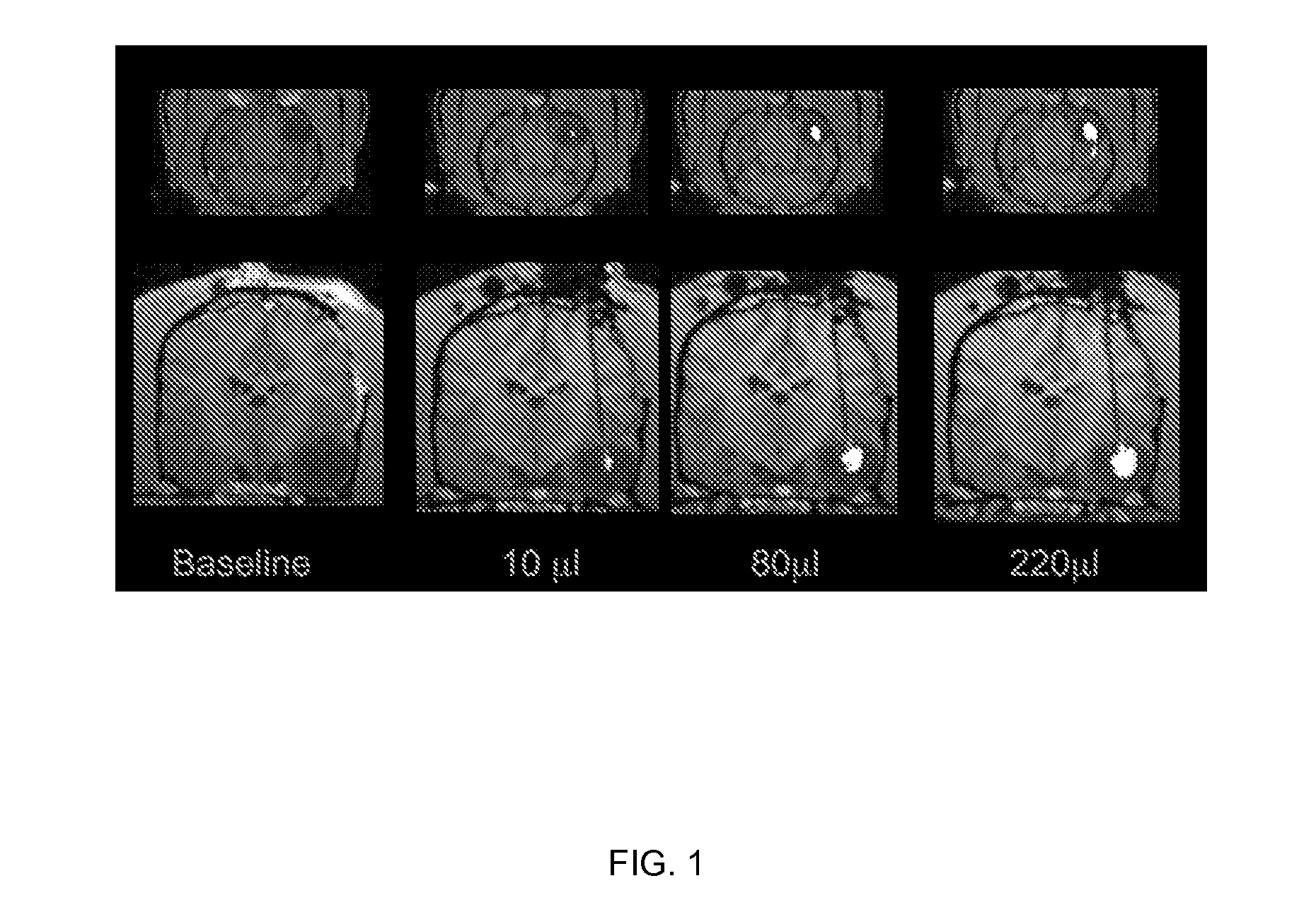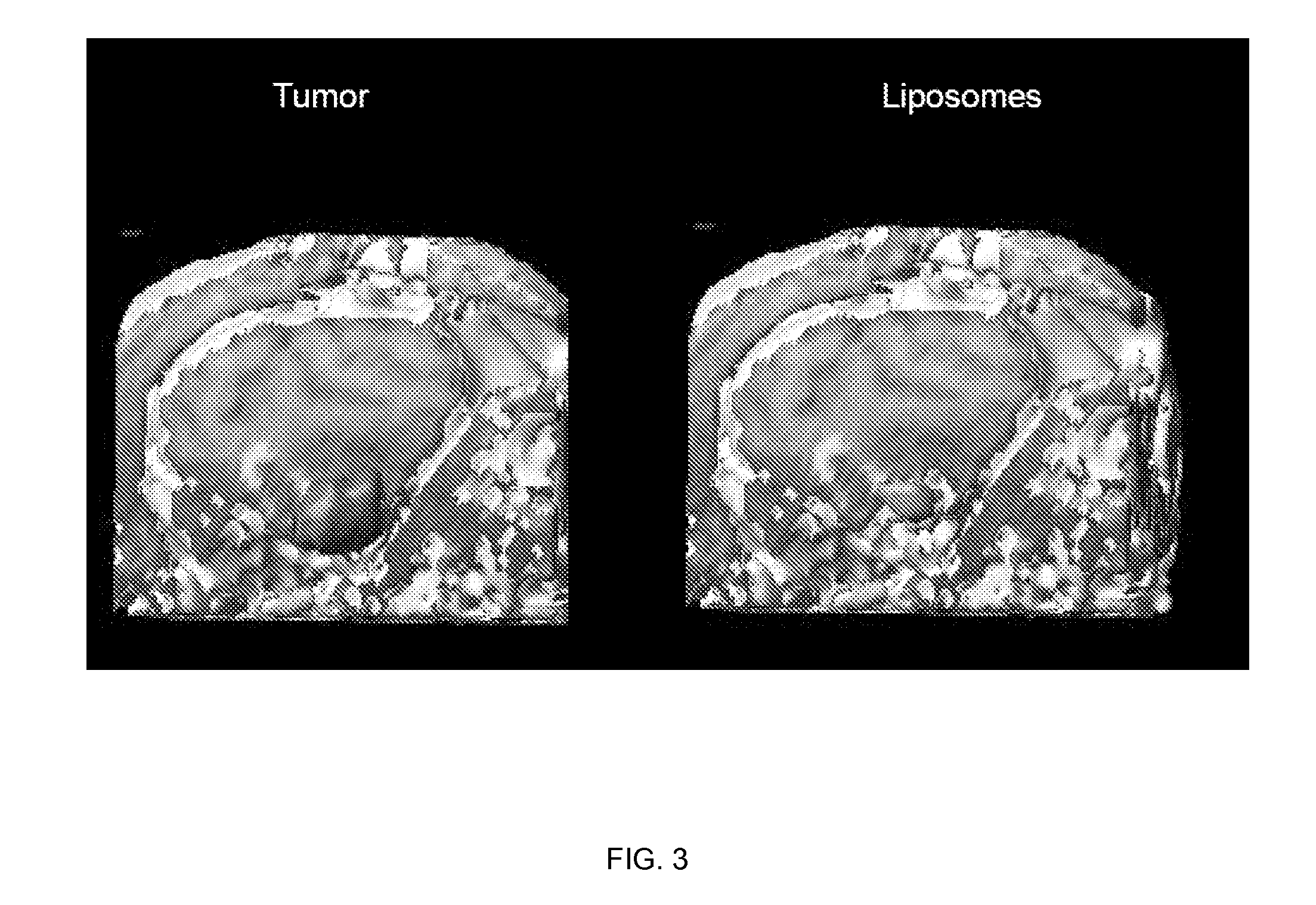Compositions and methods for convection enhanced delivery of high molecular weight neurotherapeutics
- Summary
- Abstract
- Description
- Claims
- Application Information
AI Technical Summary
Benefits of technology
Problems solved by technology
Method used
Image
Examples
example 1
Gadolinium-Loaded Liposomes Allow for Real-Time Magnetic Resonance Imaging of Convection-Enhanced Delivery in the Primate Brain
[0181] The robust distribution of liposomes obtained in small rodent brains in the prior art did not guarantee similar results in the much larger primate CNS. Therefore, several key factors were further explored in the present studies. These included correlating the volume of infusion and volume of distribution in larger brains, developing a real-time imaging system, establishing the convectabilty of high molecular weight therapeutics in large mammal brain, and evaluating the accuracy of MRI monitoring for detection of liposome distribution.
[0182] Distribution of liposomes after convection-enhanced delivery detected by fluorescence labeling (data not shown): In order to test the feasibility of CED of liposomes in the non-human primate brain, liposomes (20 mM phospholipids) loaded with fluorescent dyes (either rhodamine or Dil-DS, the difference in fluoresc...
example 2
Real-Time Visualization and Characterization of Liposomal Delivery into the Monkey Brain by Magnetic Resonance Imaging
[0188] Magnet resonance imaging of Gadoteridol-loaded liposomes during CED in primate brain (data not shown): Infusion was started simultaneously in all three targeted regions (brainstem, putamen and corona radiata) of primate CNS, and placement of cannulas was verified before infusion pumps were turned on. After stabilization of animal vital signs, up to 700 μl of liposomes was convected with increasing rates of infusion. Robust and reflux-free Vd was achieved at all 3 sites. Brainstem infusion distributed rostrally towards mid-brain and caudal towards medulla oblongata. Some distribution into cerebellum via superior cerebellar peduncle was seen at 700 μl infusion. Liposomal distribution in corona radiata was primarily confined to white matter, and distributed into the non-infused contralateral hemisphere via corpus callosum above 500 μl infusion volume. Infusion i...
example 3
Effects of the Perivascular Space on Convection-Enhanced Delivery of Liposomes in Primate Putamen
[0193] MRI monitored leakage out of non-human primate striatum after liposomal infusion (data not shown): We established a method to monitor in real time the infusion of liposomes loaded with a surrogate marker. We then used this system to infuse various anatomical structures in non-human primate brain including putamen. CED of up to 300 μl of liposomes was performed in non-human primate putamen, and subsequent distribution was monitored. Placement of cannula in primate putamen was verified for each animal by MRI prior infusion of liposomes. MRI was used to monitor CED of liposomes throughout the infusion procedure and reflux-free delivery was established to ensure optimal convection parameters. After starting the primate putamen infusion procedure, signal enhancement was detected in the perivascular space of the medial cerebral artery (MCA). At the lateral putamen border, lateral stria...
PUM
| Property | Measurement | Unit |
|---|---|---|
| Diameter | aaaaa | aaaaa |
| Atomic weight | aaaaa | aaaaa |
| Composition | aaaaa | aaaaa |
Abstract
Description
Claims
Application Information
 Login to View More
Login to View More - R&D
- Intellectual Property
- Life Sciences
- Materials
- Tech Scout
- Unparalleled Data Quality
- Higher Quality Content
- 60% Fewer Hallucinations
Browse by: Latest US Patents, China's latest patents, Technical Efficacy Thesaurus, Application Domain, Technology Topic, Popular Technical Reports.
© 2025 PatSnap. All rights reserved.Legal|Privacy policy|Modern Slavery Act Transparency Statement|Sitemap|About US| Contact US: help@patsnap.com



